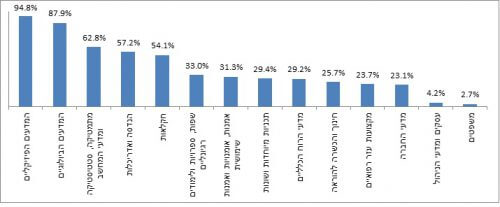This is according to the report of degree recipients in research courses at universities, in the years 2016/17-2006/07, published yesterday by the Central Bureau of Statistics, however, the rate of those graduating with a research degree (with a thesis) in the natural sciences and the exact sciences is much higher than the rate of those studying for a master's degree in law, business and management - most of them graduated without a thesis

The number of recipients of a master's degree in a research track has remained relatively stable over the past decade - approximately 3,800 per year. Actually 3,777 in 2006/07 and 3,884 in 2016 (17/2016). This is according to the report of degree recipients in research courses at universities, in the years 17/2006-07/XNUMX (XNUMX/XNUMX-XNUMX/XNUMX) that was published yesterday by the Central Bureau of Statistics, recipients of research master's degrees and PhDs who studied at universities in Israel took an important part in the research carried out at the universities.
In 2017, 5,503 people graduated with research degrees at universities, 13.5% of all those graduating with degrees at universities this year. The number of research master's degree recipients has remained relatively stable over the past decade, 3,777 in 2006/07 and 3,884 in 2016/17. In contrast, the number of PhD recipients was on the rise, from 1,288 in 1,619 to 28.1 in 66.8. Master's degree recipients in the research track were less than one-third (1990%) of all master's degree recipients in 91, compared to about two-thirds (XNUMX%) in XNUMX/XNUMX. This is due to an increase that occurred in the nineties in the number of recipients of a master's degree without a thesis.
In the experimental fields of the natural sciences there was a high percentage of master's degree recipients who submitted a thesis, 94.8% in the physical sciences and 87.9% in the biological sciences. In contrast, in law and business and management sciences there was a low percentage of thesis submitters among master's degree graduates (2.7% and 4.2%, respectively).
The percentage of those graduating to study in the research track among those receiving a master's degree in the humanities and social sciences was relatively low (28.5% and 23.1%, respectively), however their relative share differs considerably between the different universities. Among those receiving a master's degree in social sciences at Ben-Gurion University, 42.6% completed the research track, compared to 13.7% at Haifa University. Among the faculties of humanities at the Hebrew University, the percentage of those graduating with a master's degree with a thesis was the highest (42.2%) and at the University of Haifa - the lowest (20.1%).
Continuing studies for a master's degree in the research track (with a thesis)
6.4% of bachelor's degree recipients in 2009/10, also completed a master's degree with a thesis by 41.6/35.6. Among the recipients of a bachelor's degree in the physical and biological sciences in 5, the percentage of those who continued and completed a master's degree in the research track was very high (3% and 2% respectively; Chart 1). That is, one out of every 12-0.3 bachelor's degree graduates in these fields went on to research at the master's level. In the general social sciences and humanities, the chance of bachelor's degree graduates to complete a research master's degree was approximately 0.6 in 300. In contrast, among bachelor's degree graduates in the fields of business and management sciences and law, less than 170 percent went on to a research master's degree (XNUMX% and XNUMX%, respectively). That is, only one out of XNUMX bachelor's degree graduates in business and management sciences and one out of XNUMX law graduates went on to a research master's degree.
Among those receiving a bachelor's degree from the universities in 11.8, the chance of continuing to a master's degree in a research track at the universities was 2.3%, compared to 2.2% among the graduates of the academic colleges, 1.6% among the university graduates and 33.3% among the graduates of the colleges of education. Although the chance of bachelor's degree graduates in physical sciences and biological sciences from the academic colleges to continue to a research master's degree was relatively high (32.0% and 46.0%, respectively), it is still lower than the chances of university graduates in these fields (36.9% and XNUMX%, respectively) .
Continue studies for a third degree
2.2% of all bachelor's degree graduates in 4.0 completed a third degree within about a decade. The percentage of those graduating with a PhD among university graduates was high (0.2%) compared to graduates of colleges of education (0.1%) and non-budgeted colleges (1%). 5 in 22.5 bachelor's degree graduates in the physical sciences (19.0%) and biological sciences (1%) received a third degree, compared to 77 in XNUMX among education and social science graduates.
Chart 6 - The percentage of those who go on to a third degree among all bachelor's degree graduates in XNUMX, according to the type of institution where they received their first degree
Field of Study
In 46.7, the field of study of about half (33.8%) of all Ph.D. degree recipients was mathematics and natural sciences compared to about a third (13.5%) among the research second degree graduates and only 13.2% among the bachelor's degree graduates. On the other hand, in the social sciences the trend is the opposite, 19.7% of third degree recipients, 37.0% of research master's degree graduates and XNUMX% of first degree recipients.

women
The percentage of women among research master's degree recipients in 57.3 (56.7%) was similar to their percentage among bachelor's degree recipients (53.1%), and slightly lower among third degree recipients (27.5%). In the field of mathematics, statistics and computer science, the percentage of women among those receiving a third degree is the same as their percentage in the first degree (39.3%). On the other hand, in physical sciences the percentage of women among third degree recipients (33.0%) was higher than the percentage of women among first degree recipients (46.1%). On the other hand, in the field of law, the percentage of women who received a third degree (56.0%) was significantly lower than the percentage among bachelor's degree recipients (XNUMX%).
Duration of studies for the various degrees
The usual length of time in Israel to complete a PhD is 4 years of study. In practice, 17.1% of 4 graduates completed their degree within 83.3 years of study. About two-thirds of the 7 graduates completed their degree within six years of study and 5% - completed within 26.6 years of study. The most common length of time to complete a PhD is XNUMX years of study (XNUMX% of graduates completed this period of time).
The usual length of time in Israel to complete a master's degree is 2 years of study. In practice, 38.7% of the graduates of the research track in 2 did finish their degree within 66.4 years of study, compared to 3% among the graduates of the non-research track. The most common length of time to complete a master's degree in the research track is 29.6 years of study (3%). About two-thirds of the graduates of the track in 85.2 completed their degree within 4 years of study and XNUMX% completed it within XNUMX years of study.
Continue to research degrees by population group
Among bachelor's degree graduates in 6.6, the percentage of those continuing to research master's degrees among Jews (3.9%) was higher than among Arabs (2.4%). Also the percentage of those continuing to a third degree among Jews who graduated with a bachelor's degree in 0.5 (4.5%) was higher than among the Arabs (XNUMX%). In other words, the chance of a Jew with a bachelor's degree to get a third degree is XNUMX times higher than the chance of an Arab.
Natural sciences and engineering versus humanities and social sciences by population group
The distribution of bachelor's degree graduates in natural sciences and engineering on the one hand and society and spirituality on the other hand among Jews and Arabs is similar, about 70% graduated in the fields of humanities and social sciences versus about 30% in natural sciences and engineering. In both groups, the percentage of graduates in natural sciences and engineering with research degrees (second research and third) is higher than among the first degree. In the master's degree studies, the relative share of graduates in natural sciences and engineering is higher among the Arabs (59.0%) than among the Jews (55.8%). In contrast, in the third degree, half of the Arabs completed the degree in natural sciences and engineering compared to 60% among the Jews.
Continue to research degrees by education stream
Among the graduates of a bachelor's degree in 7.5, the percentage of those who go on to a research master's degree among Jews who graduated from the state education (6.1%) is higher than among the graduates of the state-religious education (2.8%). Also, the percentage of those continuing to a third degree among bachelor's degree graduates who studied in state education (2.2%) was higher than among those who studied in state-religious education (XNUMX%).
The relative share of those receiving a degree in the fields of natural sciences and engineering was higher among the graduates of the state education than among the state-religious education. These differences are particularly evident in the third degree, 71.9% among graduates of state education compared to 56.9% among graduates of state-religious education.

One response
Are the data corrected in relation to the size of the population? In relation to the general student message? Otherwise, it's clearly missing information.